This butter pound cake recipe is a classic, old fashioned cake recipe. With its rich, buttery flavor, and moist and tender crumbs, this cake is all about comfort and indulgence.
You can enjoy it on its own, paired with a cup of tea, or fill and cover with a your frosting of choice. Either way, this butter pound cake is a true crowd-pleaser that never goes out of style.
The cake is very simple and easy to make and if you are new to baking cakes, this is an excellent cake recipe to start with.
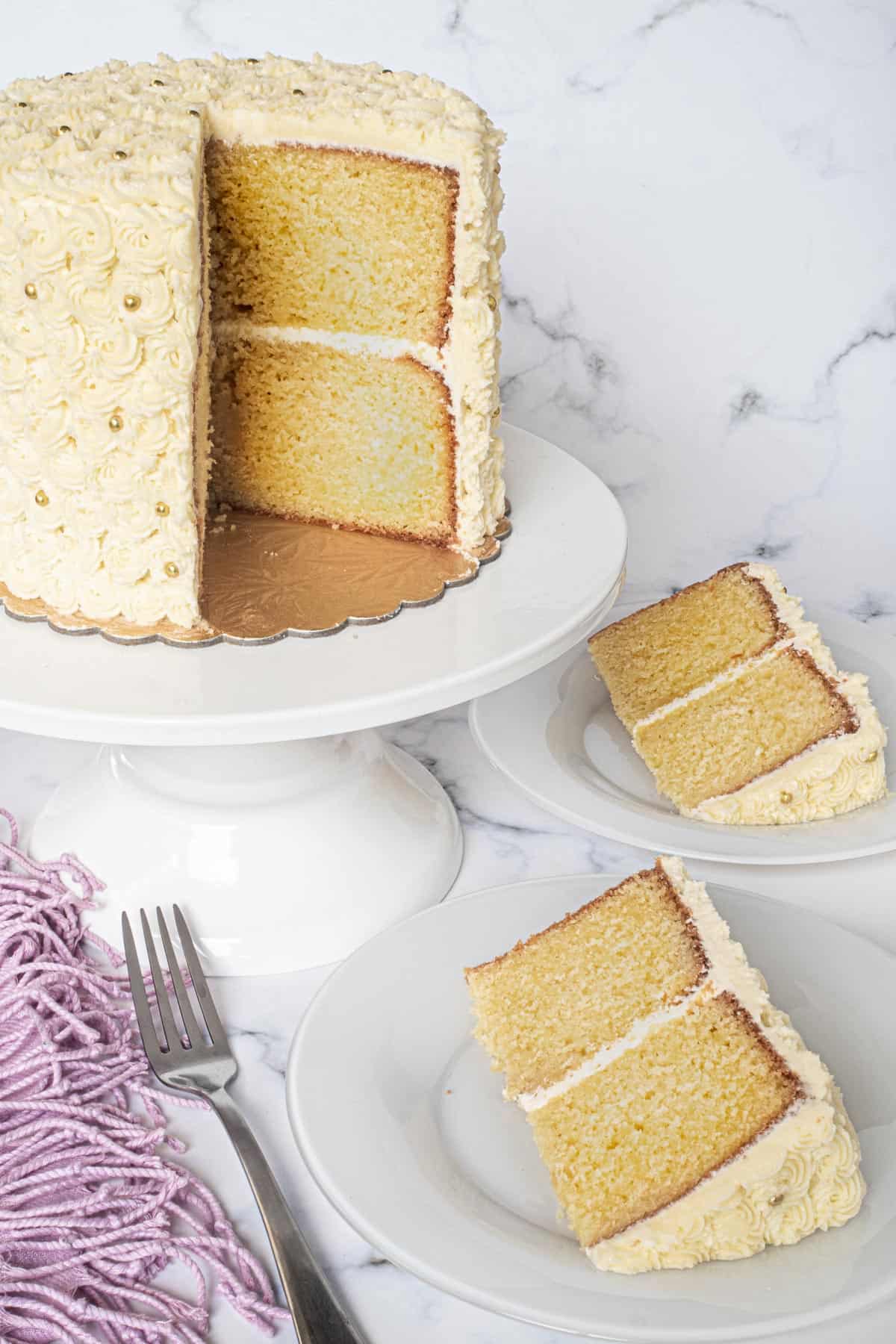
Here are my other pound cake recipes you should check out too:
- Banana Pound Cake
- Earl Grey Pound Cake
- Matcha Pound Cake
- Lime Pound Cake
- Lemon Pound Cake
- Chocolate Sour Cream Pound Cake
Jump to:
❤️Why you will love this recipe
- The cake has a moist and fluffy texture, and is absolutely delicious.
- Unlike a traditional pound cake recipe where the weight of all the four main and ingredients (flour, butter, sugar and eggs) is equal weight, this butter pound cake recipe does not require eggs to be measured by weight, instead they are measured in quantity for ease of making.
- This recipe also includes some milk and this helps with the soft and moist texture of the cake. There are no other ingredients in this classic pound cake recipe other than the small amount of salt and vanilla, and that makes this a super simple and easy vanilla pound cake recipe.
- I have calculated the recipe for various cake tin sizes, so if you want to use this easy recipe to make pound cakes in various different round and square cake tins, you have the full ingredients measure below in the recipe card.
- This butter pound cake can be enjoyed without any frosting, and works perfectly well when frosted too!
Seen on this page is my layered butter pound cake frosted with vanilla buttercream. This cake can also be frosted with a simple lemon glaze, caramel drizzle or even cream cheese frosting. The choice is yours!
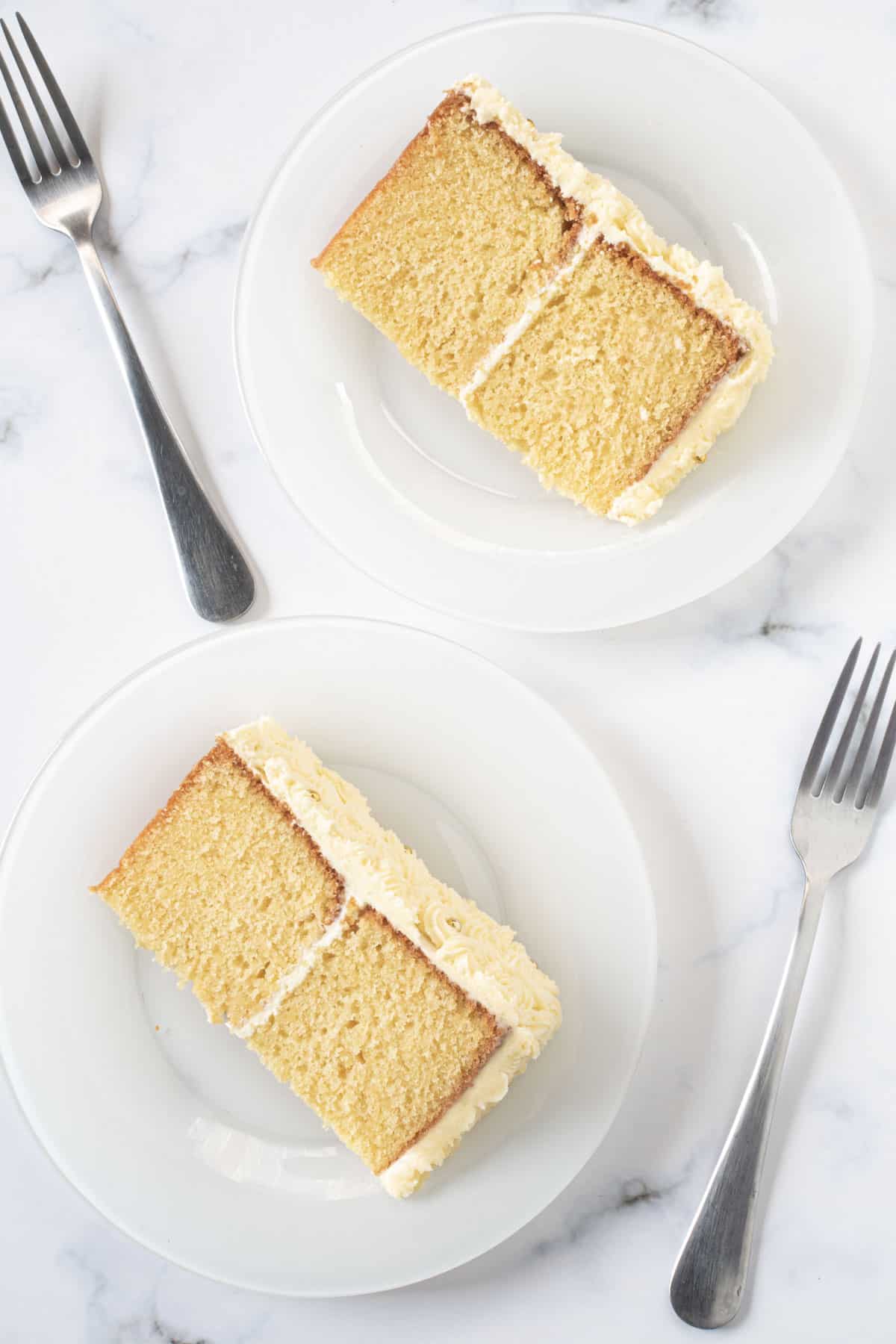
📋Ingredients
Cake
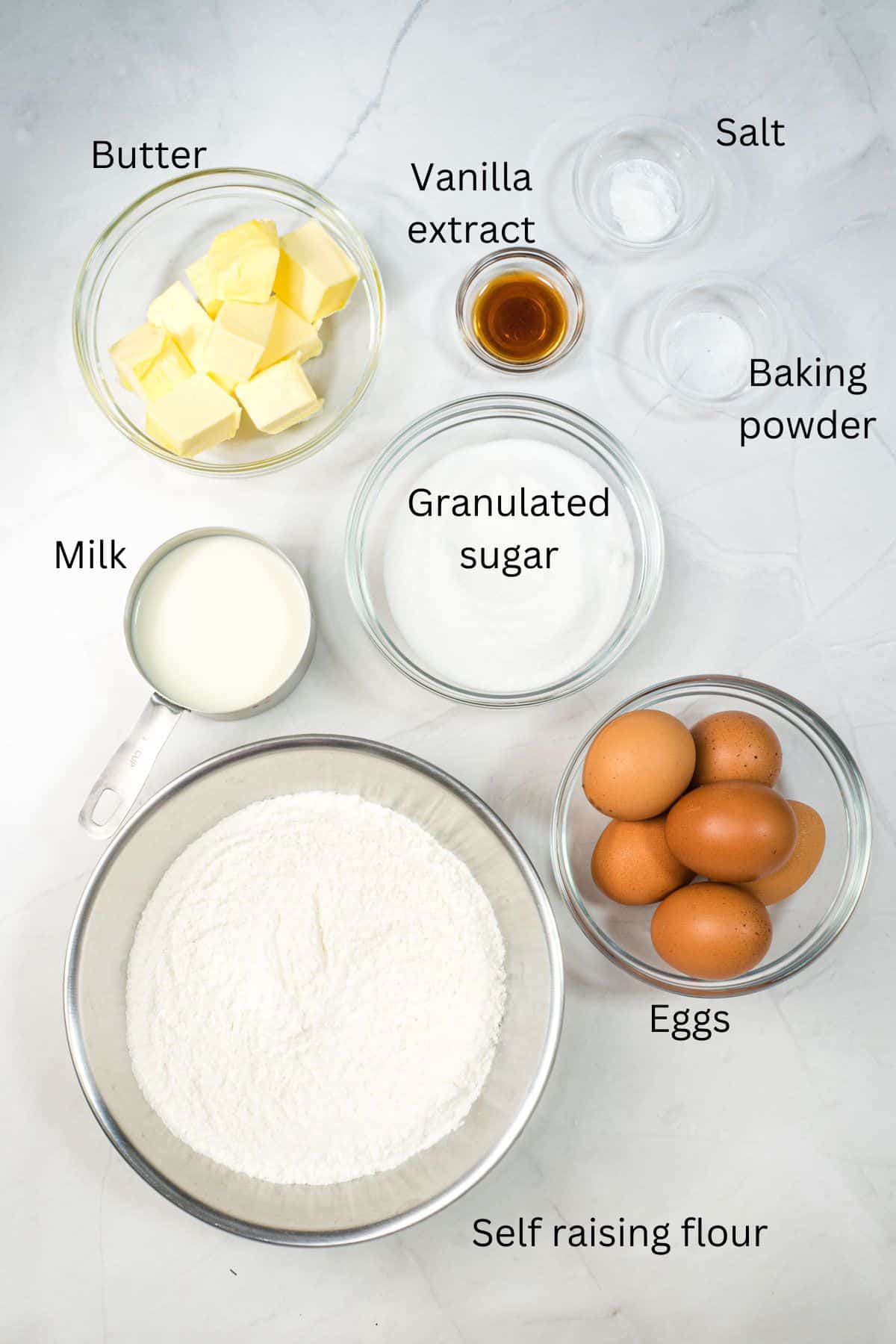
- Self raising flour + baking powder + salt - mix these well and sift them together before adding into the cake batter. Use fine salt.
- Butter - I use salted butter. If you wish to use unsalted butter, add an extra one eighth of a teaspoon of salt in the recipe. Scale it accordingly if you scale the recipe for large cakes.
- Granulated sugar (caster sugar) - coarse white sugar will leave little specks of sugar on the top of the cakes after baking. For best results, use granulated sugar.
- Eggs - Use large eggs (large sized).
- Whole milk - adds to the moisture of the cake.
- Vanilla extract - adds a lovely aroma and flavoring to the cake.
Buttercream frosting
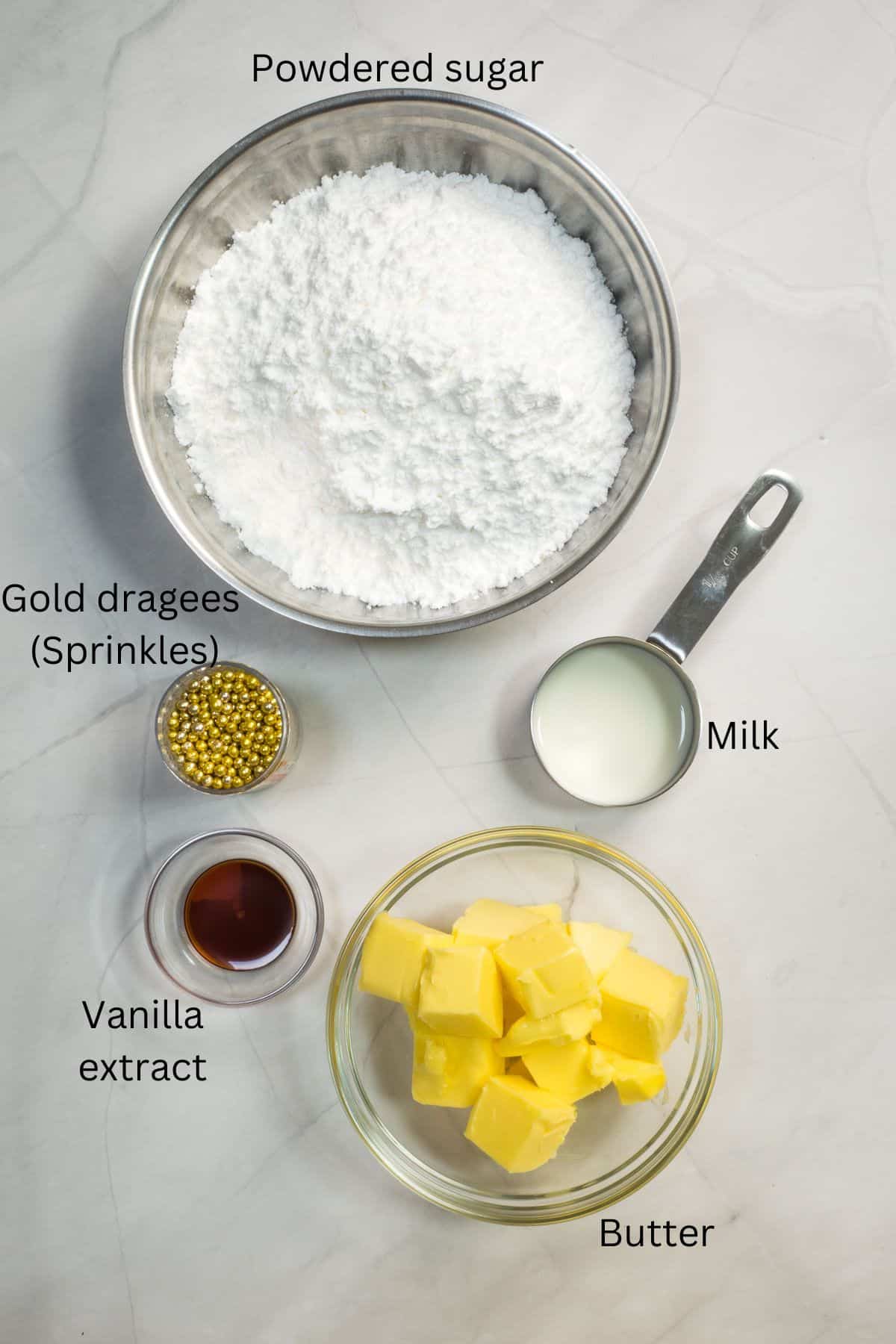
- Butter - I use salted butter. The salt truly enhances the taste of the buttercream. It does not make the buttercream salty.
- Powdered sugar (icing sugar) - sift first before adding to the butter to break all lumps.
- Milk or cream (optional) - add this in increments of about 1 teaspoon each time. This is only required if your buttercream is stiff.
- Vanilla extract- for the buttercream flavoring.
- Gold dragees (sprinkles) - for decoration only. These are optional.
*Refer to the recipe card below for full list of ingredients and exact quantities. For best results, use a digital kitchen scale where applicable*
🧾Substitution and Variations
- Self raising flour can be substituted with all purpose flour and baking powder. For every 225g of self raising flour, use one and half teaspoons of baking powder. Mix well and sift them 3 times before using. For 360g of flour (as per the recipe card below), use two and half teaspoons of baking powder in addition to that indicated in the recipe.
- This pound cake can also be made in a loaf pan. Half the recipe in the recipe card below and bake the cake in a loaf pan measuring 8 inches by 4 inches.
- Other than baking in layers and frosting with buttercream, this butter pound cake can also be baked into a bundt cake in a bundt pan or tube pan. Half the recipe and bake in a 6 cups capacity bundt tin at 160 degrees Celsius for 30 minutes. Make sure to not fill the cake tin with batter until full. Leave some space (about ⅓ of the tin height) for the cake to rise.
- And instead of frosting with buttercream, you can also use chocolate ganache or cream cheese frosting. Other serving suggestions would be with whipped cream or mascarpone whipped cream, ice cream and fresh fruit like fresh berries on the side.
- For more heat stable buttercream, replace half of the butter with shortening when making the buttercream. Do not replace the butter in the cake with shortening.
This recipe has not been tested with other substitutions or variations. If you do try, please let me know in the comments section below!
👩🍳How to Make
Mixing the cake batter
- This is a butter cake, and made using the creaming method. This means the butter and sugar are creamed together before other ingredients are added in.
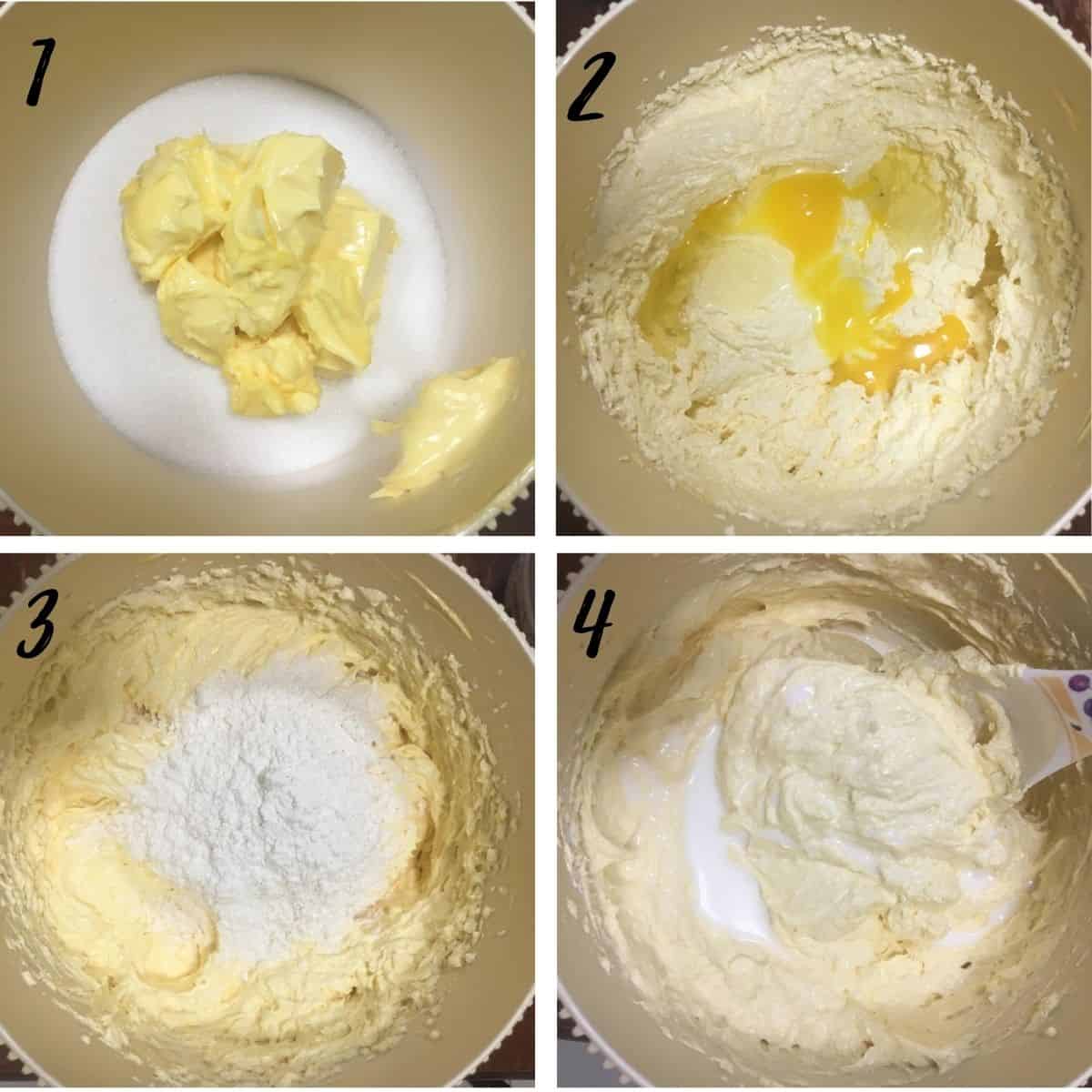
- Cream butter and sugar in a large bowl until light and fluffy (on medium speed with an electric mixer (stand mixer or hand mixer)). This is an important step for a fluffy cake, so be sure to beat these until they are really light. For the recipe below, this should take at least 2 minutes. Scrape the bowl at least once to make sure there is no butter or sugar left out unbeaten on the sides of the bowl.
- Next, add in the eggs. Add them one at a time. Each time, beat until the eggs are fully incorporated before adding more. When making larger butter pound cakes, you can add the eggs two or three at a time. And don’t forget to scrape your bowl every now and then.
- After the eggs, add the rest of the sifted dry ingredients and the milk. These should be alternated and added in batches. You can divide your flour mixture into 3 batches and the milk into 2. Start with the first batch of flour.
- Fold it in well, then add the first batch of milk. Mix well. Repeat with the second batch of flour, followed by the remaining milk and finish off with the third batch of flour. Finally, add the vanilla extract, give it a quick mix and pour batter into your prepared cake tins or baking pans (well greased and flour or lined).
Baking and storing the cake
- Bake the pound cakes in a preheated oven for 40 to 45 minute4s until a skewer or cake tester or wooden toothpick inserted in the center comes out without any wet batter. The top of the cakes should spring back when lightly pressed.
- Remove the cakes from the oven, let them rest in the cake tins for 2 minutes, and then turn them out onto wire rack to cool completely. Use a jam knife to loosen the sides of the tin before turning them over.
- If you are not going to serve the cakes immediately, wrap the cakes with plastic wrap (cling wrap) as soon as they turn warm and place them in the refrigerator until ready to use. This helps in keeping your cakes moist. When ready to use, remove the cakes from the fridge, let them warm up to room temperature before removing the cling wraps.
Decorating the cake
- To make the buttercream, place the butter and sifted powdered sugar in a bowl and beat until the butter and sugar turn light and creamy with a paddle attachment. Start with low speed and gradually increase to high speed. Add vanilla extract.
- If the mixture appears too stiff, add some milk or cream and beat until smooth.
- To decorate the cake, level the cake tops and sandwich them with some buttercream.
- Give the stacked layers a thin coat of buttercream crumb coat and place the cake in the refrigerator for about 10 to 15 minutes until the crumb coat sets.
- While waiting for the crumb coat to set, fit a piping bag with a star tip (I used tip number 18) and fill it with the buttercream.
- Remove the butter pound cake from the fridge and pipe out tiny rosettes with the star tip all around the sides and top of the cake. Pipe them as close to one another as possible such that there is no gap between them. If there are gaps, cover them with simple buttercream stars.
- To complete the cake decoration, add gold dragees in random order all over the sides and top of the cake.
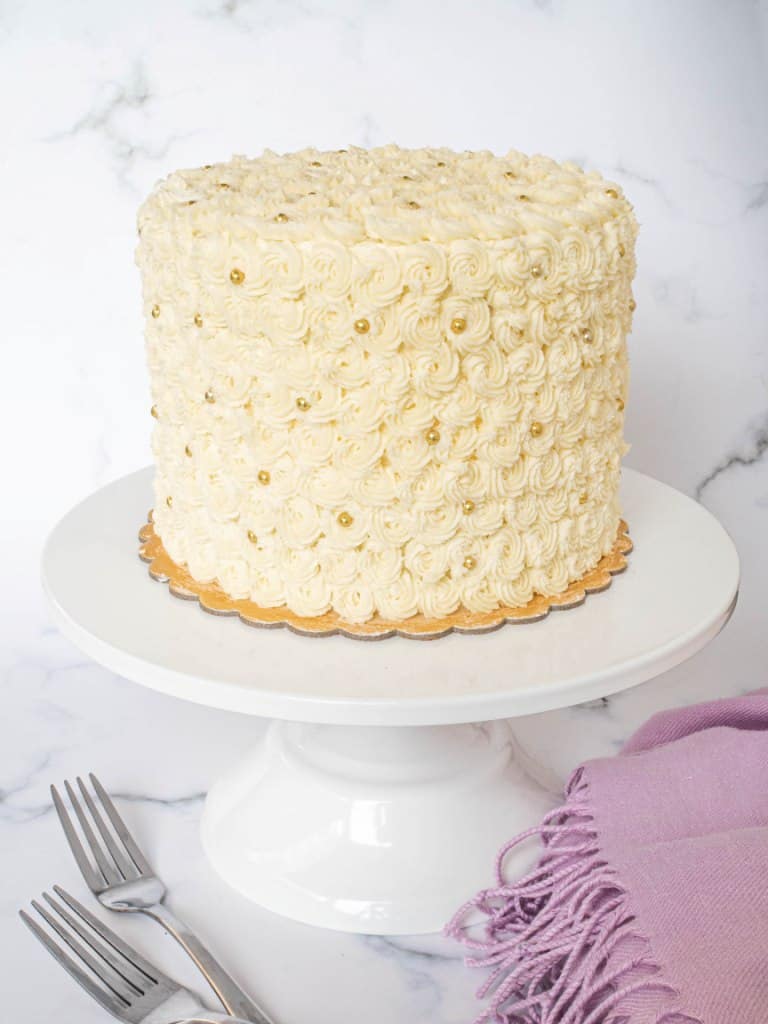
🍽️Serving & storage
- This butter pound cake can last for a good 4 to 5 days at room temperature provided it is handled without any moisture. If you wish to keep it longer, it is best refrigerated in an airtight container. Bring it back to room temperature before serving.
- The cake can also be made in advance and stored in the fridge for a good one week before using it. To do this, wrap the cake in plastic wrap (cling wrap) while it is still warm and refrigerate it. When ready to use, remove from the fridge, let it warm up to room temperature before removing the cling wrap and decorate or serve as you wish.
💡Expert Tips
- Tips for a moist texture
- Overbaking a butter pound cake will cause its texture to be dry. Under baking, on the other hand, can cause the cake to sink when you remove it from the oven.
- Always keep to the baking time indicated in the recipe and test for doneness by checking with a skewer inserted in the center of the cake at least 5 to 10 minutes before the baking time is up.
- If there is no wet batter sticking to the skewer, and the top of the cakes spring back when lightly pressed, the cakes are done and can be removed from the oven. Ideally, for best results, there should be soft cake crumbs sticking to your skewer (but not wet batter). If the skewer comes out totally clean, the cake could have been over baked.

💭FAQs
I have provided cakes tin size guide in my recipe card below. Follow this if you wish to make larger cakes. Baking with too much batter in a single cake tin will require longer baking time, and this, in turn, can cause the sides of your cake to dry out while waiting for the cake center to bake. It can also cause the cake batter to overflow as the cake rises in the oven.
If you want tall cakes, it is best to bake more layers of the cake and stack them up rather than filling up all the batter in a single cake tin.
For cakes larger than 10 inches in diameter, it is advisable to use cake strips or heating cores. These help the cakes to bake evenly and prevent them from drying out due to longer baking time.
You can read all about these in my post here on how to use cake strips and heating cores for evenly baked cakes.
Pound cake got its name from the weight of the ingredients used in making it. Originally, pound cakes are made using 4 simple ingredients – flour, sugar, butter, and eggs. And each of these is added in equal weights of one pound each, i.e. one pound of butter, one pound of flour, one pound of sugar and one pound of eggs, hence the name pound cake.
There are a lot of variations to these pound cakes now, not only in terms of the weight of the ingredients used but also in terms of inclusion of other flavorings and ingredients.
Pound cakes are made using equal weights of flour, butter, sugar and eggs. Butter cakes, on the other hand, can vary and are often not as dense as pound cakes.
❤️More Recipes You Will Love
Do you like this recipe? Please leave a 5-star ⭐⭐⭐⭐⭐rating in the recipe card below and consider a review further down this page. I would love to hear from you. Thank you!
📖Recipe
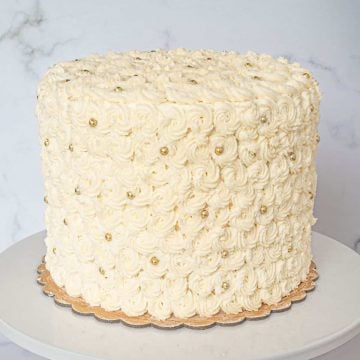
Butter Pound Cake with Buttercream Frosting
For best results, use the metrics measurements. US customary measurements have not been tested and are only meant for guide.
Ingredients
Cake
- 360 g self-raising flour
- 360 g granulated sugar
- 360 g butter at room temperature
- 6 eggs at room temperature
- 90 ml milk
- ¾ teaspoon baking powder
- ¼ teaspoon salt
- 1 teaspoon vanilla extract
Frosting
- 600 g powdered sugar sifted
- 300 g butter salted
- 2 tablespoon milk optional
- 1 teaspoon vanilla extract
Decoration
- Edible gold dragees
Instructions
- Preheat oven to 170 °Celsius.
- Beat butter and sugar till soft and creamy for about 2 minutes. Add eggs, one at a time, beating well after each addition.
- In a separate bowl, sift flour, baking powder, and salt. Fold in the sifted ingredients into the creamed mixture alternately with milk, starting and ending with flour.
- Finally, add in vanilla extract and combine well. Pour batter into two greased and floured cake pans and bake for 40 to 45 minutes until the top of the cakes spring back when lightly pressed. The cakes are done when a skewer inserted in the center of the cakes come out without any wet batter.
- Remove the cakes from oven and let them cool completely before icing and decorating.
- Baking time may vary slightly for larger cakes.
- To make the buttercream frosting, place butter in a large bowl. Beat until creamy.
- Add the sifted powdered sugar and continue to beat until the icing turns light and fluffy. Add the vanilla extract and beat again until the vanilla is well incorporated. If the icing is too stiff, add some milk or cream and beat again.
- To decorate the cake, level the top of each cake and fill the cake layers with buttercream. Transfer remaining buttercream into a piping bag fitted with a star tip. Pipe small rosettes all over the top and sides of the cake. Decorate with the gold dragees.
Notes
- Self raising flour can be substituted with all purpose flour. To make 360g of self raising flour, add two and half teaspoons of baking powder (in addition to the amount of baking powder indicated in the recipe card) to 360g of all purpose flour. Mix both well and sift them three times before using.
- To make a loaf cake, half the recipe and bake in a loaf pan measuring 8 inches by 4 inches.
- To make a bundt cake, half the recipe and bake the cake in a 6 cups capacity bundt tin at 160 degrees Celsius for 30 minutes. Do not fill the cake tin with batter until full. Leave some space (about ⅓ of the tin height) for the cake to rise.
- For more heat stable buttercream, replace half of the butter with shortening when making the buttercream. Do not replace the butter in the cake with shortening.
Calculated Tin Sizes
6 inches round/ 5 inches square (makes 2 layers of approximately 2 inch high cakes)- 240 g butter
- 240 g granulated sugar
- 240 g self-raising flour
- 4 eggs
- 60 ml milk
- ⅛ teaspoon salt
- ½ teaspoon baking powder
- ¾ teaspoon vanilla extract
- 480 g butter
- 480 g granulated sugar
- 480 g self-raising flour
- 8 eggs
- 120 ml milk
- ⅓ teaspoon salt
- 1 teaspoon baking powder
- 1 ¼ teaspoon vanilla extract
- 600 g butter
- 600 g granulated sugar
- 600 g self-raising flour
- 10 eggs
- 150 ml milk
- ⅓ teaspoon salt
- 1 ¼ teaspoon baking powder
- 1 ½ teaspoon vanilla extract
- 720 g butter
- 720 g granulated sugar
- 720 g self-raising flour
- 12 eggs
- 180 ml milk
- ½ teaspoon salt
- 1 ½ teaspoon baking powder
- 2 teaspoon vanilla extract
- 840 g butter
- 840 g granulated sugar
- 840 g self-raising flour
- 14 eggs
- 210 ml milk
- ½ teaspoon salt
- 1 ¾ teaspoon baking powder
- 2 ¼ teaspoon vanilla extract
- 960 g butter
- 960 g granulated sugar
- 960 g self-raising flour
- 16 eggs
- 240 ml milk
- ⅔ teaspoon salt
- 2 teaspoon baking powder
- 2 ¾ teaspoon vanilla extract
- Larger cakes may take a longer time to bake.
- Use cake tins that are at least 3 inches high.


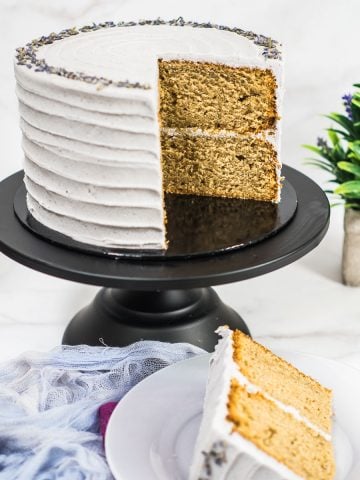
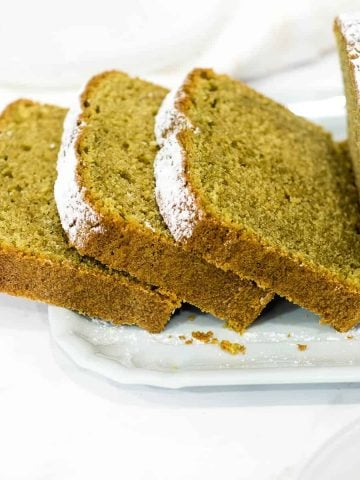
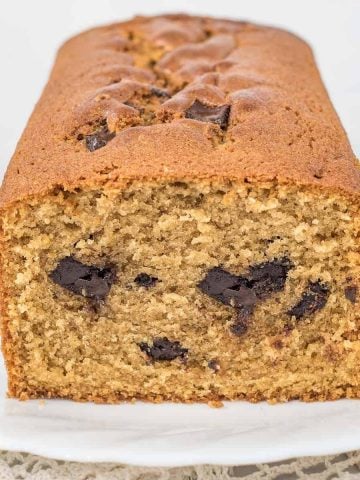
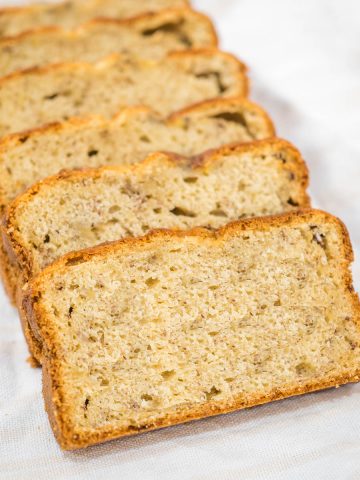
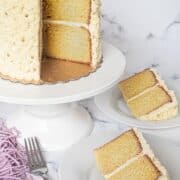
Helene
Hi, I just baked this cake:
taste fantastic
texture fantastic
Mine just had a hole in the middle. I did bake it at a lower temperature, it is fresh baking powder, did I overmix - I am usually very cautious about overmixing.
Any advise ?
Priya Maha
Hi Helena,
Did the cake sink in the middle? If yes, it could be underbaked.
But if it rose well and you find a hole in the middle, I am guessing it could be due to air bubble trapped in the batter. It could have been caused by overmixing or by the baking powder not being mixed well in the flour. Sifting the flour and baking powder for 2 or 3 times can avoid this. Hope this helps.
Rachel
I love your recipes. I use them in my tea room and get lots of compliments. Your instructions are easy to follow too. Thank you!
Priya Maha
I am glad you like my recipe, Rachel. Thank you 🙂
Keerthana
Hi Priya,
Hope you doing good.. Just came across your blog.. Really inspiring and u are doing a great job and I love your work❤️❤️.. What if I don't have self raising flour to make cakes.. How do I substitute it..